Eating in Madrid is the best part about visiting the city. Exploring Spain through food is a fun experience, and, to the surprise of many, it is a delectable tour. Spanish cuisine is diverse and varies regionally, and it includes far more than popular and famous Spanish eats like tapas and paella.

Eating in Madrid is a delightful undertaking of hearty stews, fresh produce, traditional casseroles, surprisingly-fresh seafood, high-quality meats and much, much more. Geographically, Madrid is in the center of Spain. As the national capital, Madrid is also positioned as the cultural center.
Traditions in food and drink from around Spain are present in Madrid, making the city an excellent place to sample Spanish cuisine. But Madrid is more than a melting pot. Like many other regions in Spain, Madrid has its own versions of popular dishes and its own unique specialties.
Eating in Madrid for tourists comes with challenges. Navigating (avoiding) tourist restaurants and trying to eat cheap can seem like a daunting task. Then there’s the language barrier. Neighboring capital city Lisbon stuns many tourists with the abundance and level of English spoken. Not in Madrid. Many Spaniards know English, but for one reason or another, there is little English spoken in the country. The prominent primary use of their native tongue only makes Madrid a more interesting place to visit.
Before visiting the Spanish capital, and to ensure a thorough, affordable and delicious tasting of local food, here’s everything you need to know about eating in Madrid:
Contents
Eating Cheap in Madrid
Big cities are typically more expensive than smaller ones. Price hikes usually extend to food, too. Capital cities also tend to have added costs. Madrid fits both of these descriptions, and it is one of the more expensive cities in Spain. That doesn’t mean you can’t eat cheap.
Eating cheap in Madrid is easy. It’s also easy to find more expensive food in Madrid, but budget travelers and backpackers can still get a taste of local food without breaking the bank.
Eating in Madrid, in general, is fairly affordable. In comparison, food in Madrid is cheaper than many places in the US and certainly cheaper than eating in places like Amsterdam, Munich or London.
Food in Madrid, like all of Spain, begins and ends with jamón. Enjoying the Spanish delicacy doesn’t have to be expensive. There are several varieties of jamón ranging from cheap to expensive.
There’s more info on jamón below, but just know that the cheap stuff is fantastic, especially to the inexperienced palate of foreigners. Spaniards know better, but for those of us less familiar with the intricacies of jamón, there’s no need to spend too much money at first. It’s like wine. You wouldn’t waste an expensive bottle of wine on a first-time wine drinker, right?
The cheapest way to eat local food in Madrid is to head to the supermarket. Buy some jamón, fresh bread, produce and local cheese. This is the perfect meal – no kitchen required. It’s fresh, satisfying and local. Food for a day or two can easily be had for a few euros. If budget concerns are of utmost importance, do this.

A bocadillo is a simple Spanish sandwich that includes most of the above ingredients. Bocadillos are typically pre-made and are sold around Madrid. The sandwich is usually on bread similar to a baguette and commonly includes jamón, cheese, mayo and perhaps greens or tomato. These simple sandwiches are very cheap, as little as €3-4 in many Madrid shops.
The bocadillo may be simple in origin and presentation, but it is the best way to have a cheap, quick and delicious snack. To call a bocadillo “fast food” is literally accurate, but this sandwich is not like the greasy, often-fried fast food with which most of us associate the term. You don’t have to feel guilty about eating one of these Spanish sandwiches.
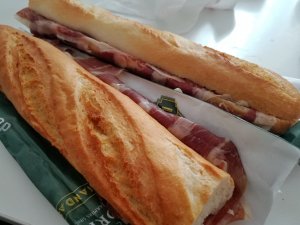
For budgets with a little more flexibility, it’s even easier to find cheap food in Madrid. Countless small neighborhood cafes (bodegas and tabernas) offer full meals for less than €10. These local restaurants are an excellent way to affordably eat local food in Madrid.
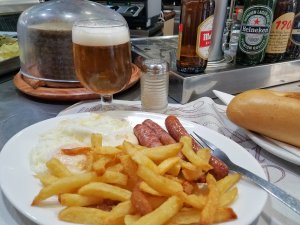
For travelers not concerned with eating healthy or fresh food, Madrid is home to several local fast food locations of 100 Montaditos. This chain is popular across Spain, and it is often packed with crowds of young people at night. It’s an ideal place for them to eat cheap food before a night at the club or wherever the party takes them.
100 Montaditos has really cheap food, in both quality and price. If cheap and fast is what you aim for, it’s an easy choice for quick food and drinks. The menu consists of small plates of various sandwiches, fries and other tapas.
For backpackers looking for a place to sit down and eat hot food with a cheap jug of beer, look no further than 100 Montaditos. Just don’t expect anything remarkable. For hangry backpackers seeking a little better experience eating in Madrid, look to neighborhood cafes.
Empanadas are popularly associated with certain South American cuisines but actually hail from Spain. While the specific place of origin is far from Madrid in the northwest corner of Spain, empanadas are plentiful in the capital.

I love empanadas. The idea, in general, may be Spanish, but they come in so many varieties that I never tire of eating them. I averaged at least one a day in Spain, more in Madrid. Empanadas are a great cheap snack, too. For about €1-2 (at a reasonable cafe/bakery), you can get an easy, on-the-go snack. And it’s filling. too. They may be filled with chicken, beef, curry potatoes, cheese and so on – empanadas come in numerous varieties.
With a little patience, eating cheap and local in Madrid is a manageable task. For strict budget travelers, you can eat (and drink) for €10 a day by exercising discipline and shopping at supermarkets. To keep food costs under €30 a day, stick to supermarkets, neighborhood cafes and places without tourists.
As far as tipping goes in Madrid, you don’t really have to tip much. It not expected in the way customary in the United States. Leaving 10% on top of your bill is generous. Usually a euro or two is more than adequate for a cheap meal.
Eating Tapas in Madrid
What about tapas in Madrid? Tapas are the most well known part of Spanish cuisine, but tapas in Madrid do not work the same way as the famous tapas scene in Granada.
For starters, tapas in Madrid are not free. Aside from the customary handful of olives or potato chips, anything beyond this usually costs. If the tapas in front of you border on a small meal and seem like a great bonus to your drink, expect drinks to be more expensive to compensate for the “free” tapas.
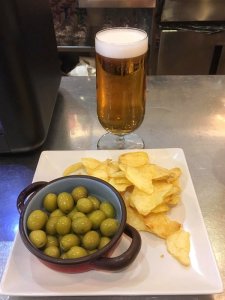
For instance, I popped into a tiny little bar in Madrid for a pre-dinner cerveza. I was pleasantly surprised to receive a nice helping of jamón, some olives and a small bowl of stew. While I was not explicitly charged for the food, the €6.50 charged for the beer clearly covered the cost of tapas.
Tapas in Madrid are typically small portions (or normal plates) of appetizers that must be specifically ordered. That being said, this is still a great way to relax, have a beer and eat with company. If you’re traveling with others or manage to make some friends, eating tapas in Madrid is a great way to try several dishes.
For a single diner, however, ordering several plates of tapas can be expensive. But there is absolutely no shame in bar-hopping for a beer or three to enjoy a few delicious tapas. Even if it costs a little more, some experiences are worth the price.
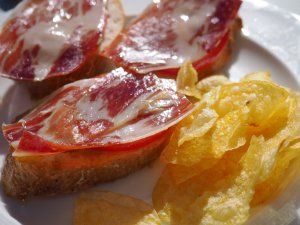
The famous culture of Spanish tapas is mainly present in Andalusia. Granada is one of the few places with widespread free tapas. Even Seville, though it has excellent food and a unique tapas scene, charges for the small plates.
The prevalent tapas culture of Andalusia is not a significant part of eating in Madrid, not in the same sense. Well, not for locals. Madrilenos certainly go out for tapas, but most of the restaurants (especially in Centro) with signs advertising tapas are trying to attract tourists.
For the most “authentic” experience eating in Madrid, forget about filling up on plates of tapas. Order an actual meal, and stick to the small snacks (olives, potato chips, etc) that come with your cerveza. The one exception to this would be if you’re eating with a local Madrileno. In that case, tapas is a great idea.
Typical Tourist Eating in Madrid
Tourism in Madrid is predominantly focused in the city center. The Centro district contains most of the tourist highlights of Madrid, such as Puerta de Sol, Plaza Mayor and the Royal Palace. Naturally, this area contains hundreds of restaurants.
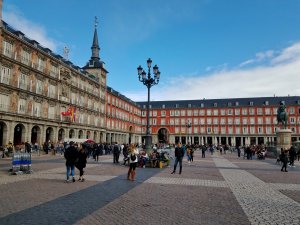
The easiest way to avoid eating at tourist traps and paying inflated tourist prices in Madrid is to go far away from Centro to the parts of the city tourists never see. While that is an excellent way to explore the city, there are still plenty of local restaurants in the city center.
Madrid is, first and foremost, a Spanish city. Tourists have yet to take over. The city center is home to over 100,000 Spaniards, and thousands more Spaniards come to the city center each day for business and/or leisure. In other words, while there are plenty of restaurants in the center of Madrid targeting tourists, there are even more to serve locals.
There are a few simple rules that are the best starting point for eating local in Madrid:
- Oh, they have paella?! Stop right there. Paella is not a Madrid dish.
- If the signs are in English, keep moving. This isn’t Amsterdam.
- If there are no locals and lots of tourists – even if there’s a long line – eat elsewhere.
- Lots of pictures of food on the outside of the building and on the menu is a great indicator of a tourist restaurant.
- Restaurants with extensive menus and a huge variety of food are for suckers and tourists. Keep it simple. Stay away.
Museo del Jamón
Sadly, Museo del Jamón is not actually a museum dedicated to Spanish ham. I was fairly disappointed to learn this. The idea of visiting such a museum is very appealing, but, at least in Madrid, it does not exist.
Museo del Jamón is a chain of restaurants around Madrid. There are a few locations spread across the city, including one directly in Plaza Mayor. Seeing this location (and based on the name), I assumed this is a tourist trap. After seeing other locations in less touristy parts of Madrid, my opinion changed. These other locations were full of locals.
Museo del Jamón is essentially a large deli and bar serving a variety of Spanish food and tapas. Of course, it’s centered around jamón like no other place. It is not a tourist trap, at least not all of the locations.
Mercado de San Miguel
Mercado de San Miguel is a large food hall in Madrid Centro. It is a short walk from Plaza Mayor. Mercado de San Miguel is really cool. There is a tremendous amount of Spanish food set in a cool, open building with glass on all sides. The popularity yields a vibrant atmosphere, especially on weekends and holidays. It really is a cool place.
Unfortunately, that’s where the positives end. Mercado de San Miguel is definitely a tourist trap. Ignoring the prevalence of English heard and on the signage, the prices are horrendous and the place is often absurdly packed.

Looking for a snack, I stopped at one stand to buy a couple of croquetas, which are very popular in Madrid. The croquetas I ordered in Mercado de San Miguel were more expensive than those I ate in a full service restaurant. As I strolled through the food hall, I noticed everything was more expensive than the rest of the city.
I’m absolutely an empanada fiend, and it was pure joy to see such a large display of empanadas for sale at Mercado de San Miguel. Until I saw the prices. These were easily triple the normal prices.
I decided to leave before my disappointment turned to hanger. Mercado de San Miguel is a cool place with a fun atmosphere, but if you’re on any sort of a budget when eating in Madrid, skip it. It is definitely a tourist trap.
Popular Spanish Food in Madrid
As the second-largest city in the EU and the capital city of Spain for centuries, Madrid has an abundance of restaurants representing cuisine from all corners of Spain and Europe. Some of the most popular dishes in Madrid are not especially local in origin, but have become mainstays on menus in the city.
The following are Hangry Backpacker recommendations for some of the best and most popular things for tourists to eat and try in Madrid:
Jamón
As mentioned above (and in every Hangry Backpacker food guide for Spain), jamón is Spanish cuisine. The laborious process of raising specially-bred pigs for years on a strict, yet fatty, diet yields a Spanish delicacy that is not only a mouthwatering treat. Jamón is more than a major part of eating in Madrid. It’s a part of life in Spain.
Sensitive vegetarians beware. It’s impossible to visit Madrid and not see the legs of ham dangling in every shop window or sitting in a jamónero (a vice-like stand for slicing) on every cafe counter. Supermarkets, bars, restaurants, highway rest stops and even personal kitchens are home to ham. It hangs proudly in the open air, reminding tourists at every turn that they’re in Spain.

Simply put, jamón is ham. Fancy ham, but there is nothing simple about jamón. It comes in a wide range of variety and quality, from delicious and cheap to mind-blowing and expensive.
For most American palates unfamiliar with the porky pride of Spain, jamón can be compared to prosciutto. That is a disservice, though. Jamón has a stronger taste than its Italian counterpart, and the process to create jamón – a process that involves raising the pigs for years before curing, aging and drying the meat for years – takes considerably longer than prosciutto.
The finished product may appear similar, but it is not. And whatever you do/say in Spain, DO NOT insult locals by comparing jamón to anything else. Because the truth is that jamón is unique, complex, heavenly and unmatched.

Eating jamón in Madrid is more or less the same as eating it anywhere else in Spain. Iberico is the “good stuff” while Serrano is the cheaper ham, but that is an oversimplification and a debate for Spaniards. For those of us who have not had the fortune to grow up eating jamón on a daily basis, it’s all great.
Jamón is overpriced in tourist restaurants. Many serve a lower quality ham at a painfully inflated rate. The trick to eating jamón in Madrid is the supermarket. There, you can buy a variety of jamón and sample the differences yourself for a significantly lower price.
Make no mistake. There is a noticeable difference between various types of jamón, but what many Spaniards scoff at, I would happily eat IF I could even get it in the United States. Unfortunately, thanks to some outdated importation laws courtesy of the USDA, FDA or other incompetent government agency, REAL jamón is hard to come by in the US of A.
Hopefully, if you’re reading this, that means you’re in or planning to travel to Spain soon. If that’s the case, just eat all the jamón. If not, try to make that trip happen. Spain is worth a visit for jamón (and wine) alone.
Seafood
It makes perfect sense that seafood would be a prominent feature of Spanish cuisine. The country makes up most of the Iberian peninsula and, aside from the Portuguese and French borders, is surrounded by sea.
Madrid, though, is about as far from the ocean as one can get in Spain. Directly in the center of the country, in a rather dry area with no direct or natural access to the sea, it seems reasonable that seafood in Spain would be prevalent in more coastal regions. To the surprise of many (especially this Hangry Backpacker), that is not the case. Seafood is a major part of eating in Madrid.

As the most populous part of Spain, much of the seafood that reaches the ports quickly finds its way to Madrid. Seafood dishes in Madrid include some general Spanish dishes as well as local specialties. Eating in Madrid is not complete without chowing down on some of these sea creatures:
- Pulpo a le gallega – octopus, traditionally from northern Spain but a very popular food in Madrid
- Boquerones – small, fried anchovies that are fantastic and popular across Spain
- Cazon – a small shark (dogfish) that is marinated in vinegar then fried and way too easy to eat
- Gambas – prawns, typically cooked with garlic
- Calamares bocadillo – the most traditional form of the Hangry Backpacker’s favorite cheap food in Madrid, bocadillo with fried squid

This is a sampling of delicious seafood eats that can be found in Madrid. Madrilenos also love bacalhau (Portuguese spelling), barnacles, scallops and mussels among other sea-dwelling animals. Based on my observations and restaurant menus, it appears most seafood in Madrid is served fried, but there are fresh seafood shops in every neighborhood.
The Nasty Bits
The nasty bits (as Bourdain would call them) are the parts of the animal that receive little, if any, shelf space in supermarkets. After the pretty, highly-desired cuts of meat are separated, the scraps and leftover parts of an animal still have value.
Animal extremities and innards may sound less-than-appetizing to some, but those people… they suck. If you’re not willing to eat – at the very least, willing to try – a “strange” part of an animal, you might as well switch to rabbit food, saddle up your high horse and join the growing herd of vegetarians.
Tongues, bones, brains, balls, tails, skin – these are the nasty bits. And they are excellent! Spaniards treat meat efficiently. You can find almost any part of an animal on a menu somewhere.
Callos
Perhaps the most famous nasty bit to eat in Madrid is callos. Callos is a tasty stew that consists of tripe (stomach), blood sausage (morcilla), chickpeas and some veggies. It’s a local specialty in Madrid, too.
If you like tripe, which has a chewy texture that puts off most people, you’ll love callos. Like a lot of other nasty bits and strange, edible creatures, tripe can be quite good if cooked well. Callos is the perfect way to eat it.
For those who can’t stomach the thought of callos – see what I did there? – I encourage you to at least try it. In a stew with other meat and ingredients is a great way to slowly expand your eating horizons.
Picky eaters are the worst. They’re no fun. Be fun and try something strange. You just might like it.
Where: All over Madrid; callos is a local specialty
Torreznos
Torreznos are similar to pork cracklins. Personally, I couldn’t tell the difference. For those unfamiliar with cracklings (proper spelling – in the Southern US, we drop the ‘g’), it is pretty much a piece/chunk/strip of pork skin, often with a little meat and fat attached, that is fried and seasoned.
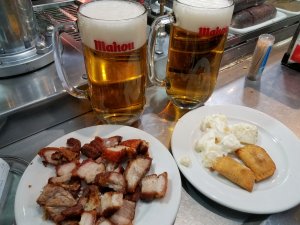
This crunchy treat is not unusual among Spanish tapas. Yes, it is exactly as unhealthy as it sounds. Torreznos are also worth every single artery-clogging bite, but maybe don’t make it an everyday thing.
This is not the same thing as a pork rind. Once you’ve had real cracklins, be that eating in Madrid or from a gas station in Louisiana, you’ll understand the difference.
Where: Los Torreznos Bar Goya
Oreja de Cerdo
This is another delicious snack that is popular in Spain. Oreja de Cerdo translates to, and really is, “pig’s ear.”
In wonderful Spanish fashion, eating in Madrid means eating food from all parts of the animal. Without wasting anything, restaurants regularly fry up pig’s ears. They’re also cooked other, healthier ways, so don’t write it off completely. I prefer Oreja de Cerdo on the crunchy side, but it often ends up similar in taste and texture to ham (not Spanish ham). It can be chewy, but better restaurants get it right.
Where: La Oreja de Jaime
Muchos Patatas
Spain isn’t internationally known for having a potato-prominent cuisine, but eating in Madrid surprisingly involves a lot of food with potatoes. Some of the popular potato dishes are excellent, while others are really not that great.
Tortillas/Omelettes
Forget about eating a Mexican-style tortilla in Madrid. And this is certainly not a hearty Colorado omelette from your local diner. A Spanish tortilla, also called an omelette, is more of a thick potato cake that looks a bit like a fluffy, round frittata.

Tortillas are simple, consisting of diced or minced potatoes, onions and eggs, grilled or baked in a pan into a round shape. It is often served as a slice (like a piece of cake), as a side item or tapas. Some tortillas are better than others, but, in general, this is one of the potato foods in Madrid that you definitely want to eat.
Where: Everywhere
Patatas Bravas
This is one of the most common tapas/appetizers/side dishes seen in Madrid, but that’s about the only interesting thing about this dish. Patatas bravas is nothing more than big chunks of fried potatoes. They are served with a sauce that resembles ketchup, but, well, it’s not ketchup.

There is too much delicious food to eat in Madrid to waste time or money eating patatas bravas. The potatoes themselves are almost as bland as a potato can be. The sauce is supposed to be a spicy sauce. However, Spaniards don’t really do spicy, so the sauce is little more than colorful, overrated “meh” on top of boring potatoes.
Where: Everywhere
Ensaladilla Rusa
Ensaladilla rusa is Spanish potato salad. It’s fantastic. Another dish commonly served as an appetizer or tapas, Spanish potato salad is a must-eat.
Like American potato salad (and probably every other country’s variations), there are surely a dozen different ways to make it, but it usually includes olive oil, boiled eggs, olives, bell peppers, onions, green onions and tomatoes. Whatever variation or concoction of ensaladilla rusa you find, eat it.

Huevos Estrellados
Huevos estrellados is another potato and egg dish that is popular in Madrid. It’s a very simple dish, basically consisting of fries and runny fried eggs. At this point, it’s nothing special. However, as soon as you add some jamón or chorizo, it’s delicious. For anyone considering knocking back more than a bit of Spanish wine, this is what you want to eat for breakfast the next morning.
Sweet Eats in Madrid
Eating in Madrid has an extra layer of fun for travelers with a sweet tooth. Sweets and desserts in Spain are a crucial part of the cuisine. This is evidenced by the bakeries (panaderia) and cake shops (pasteleria) all across every city. The same goes for Madrid.

Spain has great bread. Buying a small loaf to last a couple of days is also a great way to save money and eat the best. When the bakery window displays are too irresistible, you can cheaply buy one or two sweets to satisfy your cravings. For travelers like myself with food allergies, make sure to take precautionary measures and prepare accordingly for any language barrier.
Popular sweets and desserts in Madrid change depending on the season and holidays, so availability will differ depending on the time of your travels.

Despite that, there are some desserts that are must-eats in Madrid. Whether they’re specifically local/unique to Madrid cuisine or national sweets, here are some sweet eats to add to your bucket list menu:
- Churros Madrilena – churros vary across Spain; those in Madrid are incredible in their own way
- Ensaimada – fluffy, spiral-shaped, (sometimes) cream-filled pastry from Mallorca but very popular in Madrid – the best is at Formentor
- Flan – rich, caramel dessert found in every cafe and taberna
- Roscón de Reyes – eaten for Three Kings’ Day; seasonal cake but a must-eat if you’re in Madrid around Christmastime
- Natillas – vanilla custard perfection
- Torrijas – Spanish Toast (akin to “Spanish-style French Toast”); if you can find it, eat it!
- Manolitos – incredibly popular croissants in Madrid
After reviewing this short list, the first thing I realize is that I ate a lot more sweets in Madrid than I thought. Second, I only scratched the surface. One of the best parts about eating in Madrid is the baked goods and sweet treats.

In addition to the year-round mainstays, every holiday brings with it delicious food. The best way to experience Madrid is through food, and the best way to finish each day is with something sweet from one of the city’s many bakeries.
Hangry Backpacker Favorites
I spent a lot of time in Madrid, and my tourist activities largely consisted of sampling and eating as much local food as possible. It was a fun task. Nothing was bad, though I didn’t get to try a plate of snails.
The best thing about Madrid is the food. The most interesting aspects of the city are food, even better than the famous attractions (my apologies to the Prado). The following are some of the foods that I most enjoyed eating in Madrid.
Cocido Madrileño
This is, by far, my favorite food in Madrid. A cocido is basically a big stew with chickpeas, veggies and lots of meat. To learn more about the wonderful cocido Madrileño and to understand my love for the hearty meal, read about my favorite meal in all of Spain.

Empanadas
Empanadas (mentioned above) are always a good idea. That’s why I mention them twice. It doesn’t matter where in the world I am, I never pass up the chance to eat an empanada. Empanadas in Madrid, smaller ones called empanadillas, are equally delicious.
Croquetas
The Spanish love croquetas (croquettes). These little fried tubes of cheese and potatoes are everywhere in Madrid – cafes, bakeries, bars and nice restaurants. To the surprise of many visitors, croquetas are a Spanish staple. Like empanadas, they come in many varieties. The most common is jamón and cheese. I recommend the rabo de toro (oxtail) croquetas.

Spanish Hot Dog
What the hell is a Spanish hot dog? Is eating a hot dog in Madrid even something local people do?
Well, yeah. It’s the 21st century. Pizza is no longer Italian, and hot dogs are certainly not German. These are now global foods. Hot dogs are prevalent, in some form, in most big cities in the world. Madrid is no exception. There are several places serving dogs, from fancy to cheap. But there’s a really interesting place to eat a good, albeit funny-looking hot dog in Madrid.

Galatea is a cafe in Salamanca (district to the east of Centro). The cafe serves typical Spanish cafe eats, but it also has some “American” food on the menu. Among these is a peculiar-looking hot dog. The large dog protrudes from the bun and looks like a geoduck (a bizarre clam). Well, it looks more appetizing than that. The strange hot dog is pretty damn tasty, too.
Drinking in Madrid
The Spanish drink a fair amount. Higher than the world average, slightly higher than the United States, but less than their neighbors (Portugal, France, Andorra). Drinking in Spain just feels like a part of life. Sure, young people party and stay out late, but no one thinks twice about someone having a midday glass of wine or half-liter of beer. It’s not uncommon for people to have a drink or two during their lunch break.
Alcohol is an important part of Spanish cuisine, too. In order to really experience Madrid, you’ve got to sample some local favorites.
Wine
Spain has great wine. It is the 3rd-largest producer of wine in the world, and the country is home to a dozen distinct wine-growing regions, with each region having several sub-regions of its own. In other words, wine is serious business in Spain, and drinking in Madrid must include a taste or two of some of the world’s finest.

The Community of Madrid, the province in which the city is located, is not a prominent wine-growing region of Spain. The immediate area around Madrid is not completely devoid of vineyards and wineries, but the more prominent sub-regions and varieties are elsewhere.
That’s okay, though. Madrid has no shortage of good wine from across the country. I’m still honing my knowledge of wine (beer is usually more backpacker-friendly when I travel), but you can read more here to get a better idea of what to expect when it comes to wine in Madrid. The important thing to know about Spanish wine is that it’s good. It’s also fairly affordable, especially in Spain.
Vermouth
Spain doesn’t really have a prominent liquor that is internationally-known and associated with the country, not like Scotland (Scotch), Greece (Ouzo) or Mexico (Tequila). The closest thing to that is vermouth. And, no, it has nothing to do with Martinis or Manhattans. Vermouth in Spain is not part of some fancy cocktail. It is consumed straight.
Vermouth is essentially the national spirit of Spain. Drinking vermouth in Madrid is certainly more common than anywhere else I’ve ever seen, but it isn’t on the same level as Spanish wine or beer.
That being said, vermouth is still a big part of Spanish drinking traditions. And seeing as vermouth is fortified wine – and Spain has a lot of wine – it’s only natural that vermouth is common and popular.
Spain’s favorite spirit is of the “red” variety, which isn’t really red. Spanish vermouth is also sweet. Spaniards typically drink their vermouth with an orange slice/peel, and it’s a popular Sunday beverage. Spanish vermouth is not very strong, coming in with an alcohol content around 15%. Having never had straight vermouth prior to landing in Madrid, I was pleased. It’s great!
Beer in Madrid
What about beer? For beer-lovers, Madrid has what is probably the best situation for quality and variety in Spain. That’s part of the benefit of being in the capital and largest city.
Mahou is Madrid
Mahou is the dominant beer in Madrid. It may be owned and produced by Big Beer, but Mahou is better than most of the Big Beer products drowning customers in North America. There’s no comparison between a cold, draft Mahou and the piss-poor quality of Bud, Miller, Coors and the like.

Mahou isn’t an earth-shattering brew. It’s plenty drinkable, though, and Mahou is perfectly adequate for a cheap, mass-produced pale lager. It is the most popular beer in Madrid and available just about anywhere. Other Spanish brews, such as Estrella or Cruzcampo, are also sold in Madrid.
Mahou Clasica is the standard, but the brewery makes a variety of other beers. These include a dark beer, an IPA and an alcohol-free beer. The other varieties are okay, but the Clasica is better. As for the alcohol-free version, Mahou Sin (‘sin’ means ‘without’ in Spanish), why?
€5 is a pretty standard price for a half-liter (slightly more than a pint) of Mahou beer in Madrid. However, paying this much is not necessary. That price takes into consideration all restaurants and bars, especially those in the touristy areas where prices are higher.
A half-liter of draft beer can be found in Madrid for €2 if you look in the right places. Most of the more visibly appealing bars are more expensive. This doesn’t mean cheap beer is only available in grimy, run-down watering holes; rather, don’t expect to find cheap beer in fancy or photogenic places.
The key to finding a cheap beer in Madrid is patience. Small, neighborhood bars are very welcoming to foreigners, and the beer is usually a little cheaper. What may be an unassuming, tiny bar might be the perfect local spot for a cheap Mahou or Estrella.
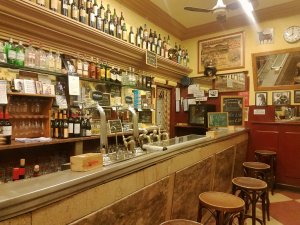
If all else fails in search of cheap beer in Madrid, two options always remain available. Doner shops, if they serve alcohol, are a great source for cheap beer. And 100 Montaditos has cheap beer to go along with the cheap food.
Craft Beer in Madrid
The craft beer scene in Madrid is okay. There are options! The entire craft beer industry in Spain is growing in presence and popularity.
Many bars in Madrid have a single tap serving a single type of beer. Many others have multiple taps serving only a couple types of beer. There is, however, a growing number of bars in Madrid with a variety of beer options available.
Variety usually consists of imports from elsewhere in Europe, but craft beer has a growing presence in the city. Much of the craft beer comes from various microbreweries around Spain. Cibeles is a solid craft beer from Madrid province. La Virgen is another good craft beer option from Madrid. Fabrica Maravillas is one of the few brewpubs in Madrid.

The world of craft beer in Madrid is small but growing. Wine is the most famous and popular alcoholic beverage in Spain, but beer-lovers can rest easy knowing that quality brews are there for the drinking in Madrid.
Eating and drinking in Madrid is the best part of visiting the city. In addition to having its own popular food, many regional dishes from throughout Spain have become popular in the capital city. For that reason, Madrid is the best place in Spain for a sampling of Spanish cuisine.
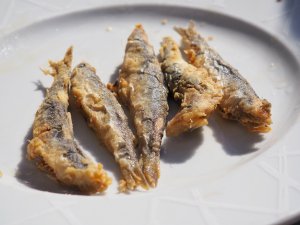
As I often say, “food and drink is an open window into another culture.” Eating in Madrid is a delightfully tasty way to explore the city and get a thorough taste of Spain.
Leave a Reply
You must be logged in to post a comment.